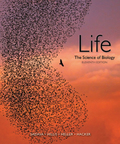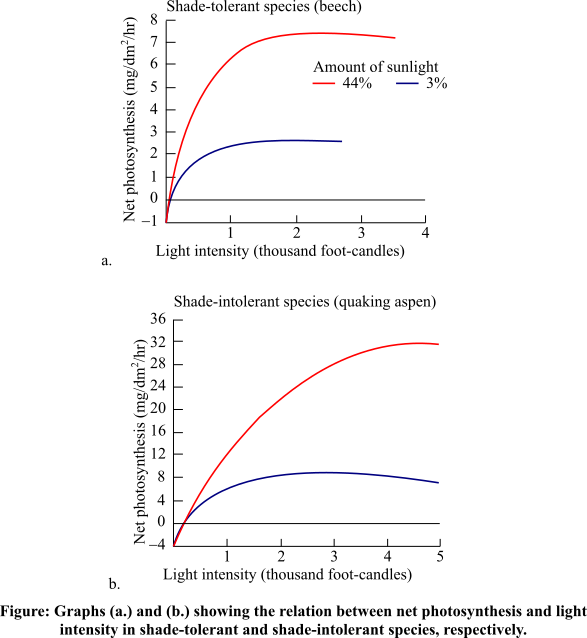
Concept explainers
To review:
The rate of photosynthesis increases in the leaf exposed to higher light intensities.
Given:
The graphs representing the rate of photosynthesis as a function of the intensity of light.

Introduction:
The process of photosynthesis is light dependent. Photosynthesis converts light energy into chemical energy. The rate of photosynthesis will increase if the leaves are exposed to the higher intensity of light.
Explanation of Solution
Photosynthesis is a light-dependent process. This process uses light energy to produce carbohydrate and provide energy to plant for various
The rate of photosynthesis increases when there are higher light intensities. The leaves, which are exposed to the higher intensity of light, show high rate of photosynthesis. At low light intensity, the leaves will show a decrease in the rate of photosynthesis. The leaves with the larger surface area and high density of chlorophyll will show a high rate of photosynthesis as they can absorb more light.
From the given graphs, it is clearly visible that both the plants show increasing rate of photosynthesis in high intensity of light (shown by orange line) and rate of photosynthesis is low in low intensity of light (shown by purple line). The photosynthesis is directly proportional to the intensity of light, so the curves of photosynthesis increase with increasing light intensities.
This occurs because of the increase in the rate of light-dependent reactions, which in turn results in the increase in photosynthesis rate. However, the rate of photosynthesis is dependent on other factors like temperature and carbon dioxide concentration. Therefore, with further increase in light intensity, the photosynthesis rate does not rise further and eventually plateaus.
Thus, it can be concluded that photosynthesis is a light-dependent process. The rate of photosynthesis is directly proportional to the intensity of the light but to a certain extent only, as photosynthesis is controlled by various other factors also.
Want to see more full solutions like this?
Chapter 10 Solutions
EBK LIFE: THE SCIENCE OF BIOLOGY
- Diagram 41 The Light Reactions of Photosynthesis STROMA Poteyte Potayate mples HAD Light HLARO ACE (high ir Carto Thylakold membrane ATP ynthase STROMA ow N concentration) ADP Diagram 4 shows a single thylakoid membrane taken from a chloroplast inside of a leaf cell. The events of the light dependent cycle that take place along the thylakoid membrane are shown. Identify an energy transfer that takes place n Diagram 4. Light energy is directly transferred into the chemical bonds of sugar. O Light energy is directly transferred into the chemical bonds of ATP The energy of the bonds of water are transferred into the chemical bonds of ATP. The energy from an excited electron is transferred into the chemical bonds of NADPH.arrow_forwardWhich of the following is in the correct order from smallest to largest? Thylakoid disk, Photosystem I, mesophyll cell, chloroplast, leaf Photosystem II, Chloroplast, thylakoid disk, mesophyll cell, leaf Thylakoid disk, Photosystem II, chloroplast, mesophyll cell, leaf Photosystem II, Thylakoid disk, chloroplast, mesophyll cell, leafarrow_forwardWould a higher leaf area index always increase the amount of photosynthesis? Explain.arrow_forward
- What are the products of the light-dependent reactions of photosynthesis? 1) production of ATP, oxygen, and NADPH O 2) production of ATP, water, and NADH 3) regeneration of NAD+ O 4) Production of G3P and ATP O 5) production of oxygen and NAD+arrow_forwardAn experiment was done to determine how color of light and distance affects photosynthetic activity of the pond weed. Pond weed was placed in a test tube containing a solution of sodium hydrogen carbonate, and had its end cut; light was placed 50 cm away and four colors were tested (clear, red, blue, and green). After placing the light, the pondweed was given a certain amount of time to adjust before counting the bubbles, bubbles were counted for 1, 3, and 5 minutes. Only the bubbles that came out of the cut end was counted to represent the rate of photosynthesis. Below is the tabulated results. What are the possible factors or errors that could have affected clear/white light to have lower photosynthetic activity? In theory this should have the highest rate.arrow_forwardUnder what environmental conditions does photorespiration “outcompete" that of the CC? Specifically, what mechanism is responsible for committing the cell to photorespiration and what type of plant does not have any "safeguards" to ensure that the CC is performed rather than photorespiration?arrow_forward
- What stages of the light-dependent reactions occur prior to the buildup of hydrogen ions in the thylakoid compartment? Select all that apply. Energy emitted by the electron transport chain triggered by PSII generates a hydrogen ion gradient across the thylakoid membrane. PSII pulls replacement electrons from water molecules, which then break apart into oxygen atoms and hydrogen ions. A photosystem II (PSII) absorbs light energy and releases an electron. Electrons released from PSII enter an electron transport chain in the thylakoid membrane. A flow of hydrogen ions causes ATP synthase to phosphorylate ATP.arrow_forwardDiscuss other morphological differences between sunny and shady set-ups of mung bean in relation to phototropic response of plants. Characteristics sunny shaded Leaf color Lime Green Pale Green Direction of Growth Grows upward towards the direction of sunlight Oriented in the direction of the light but growth is bent downwardarrow_forwardDiagram 3: Light Wave Absorption of Chlorophyll a and b. Chlorophyll a Chlorophyll b 400 450 500 550 600 650 700 Wavelength (nm) Plant chlorophyll chemicals will absorb, or take in, light wave energy in order to produce their own organic molecules used for cellular energy. Reflected light refers to those wavelengths of light that will "bounce off" of the chlorophyll and not be absorbed. Select the conclusion that most accurately summarizes the data in diagram 3. Red and blue light waves have equal importance during photosynthesis. The majority of light energy is attained from red light, while the blue light waves provide additional light energy to photosynthesis. The majority of light energy is attained from blue light, while the red light waves provide additional light energy to photosynthesis. Medium length light waves are important to photosynthesis Absorptionarrow_forward
- The green color of plants is explained by the wavelengths of light that are reflected, transmitted, and absorbed by the chlorophylls in the thylakoids. Which of the following statements is true? Plants appear green because chlorophylls reflect and transmit yellow and green wavelengths of light, and absorb red and violet-blue wavelengths of light. Plants appear green because chlorophylls reflect and transmit red and blue wavelengths of light, and absorb yellow and green wavelengths of light. Plants appear green because chlorophylls reflect and transmit red and blue wavelengths of light, and absorb white wavelength of light. Plants appear green because chlorophylls reflect and transmit white wavelength of light, and absorb red and violet-blue wavelengths of light.arrow_forwardDiscuss whether it would be more beneficial to improve the light or dark reactions in order to enhance photosynthesis for a future scenario of extreme drought conditions. Please draw sketches to illustrate and include atleast 20 pointsarrow_forward10. Observe the graph on the right. If you had a hypothetical plant that only had a hypothetical photopigment with an absorption maximum at 585, which color light would produce the highest rate of photosynthesis? ltra Violet Blue 456-492 nm Green 492677 nm Yellow Orange 597-620 nm Red intra vielet red 400-455 nm 677-697 nm 620-700 nm nm 400 500 600 700 short wtength Ieng vetength high fmuency lawhumcyarrow_forward
 Biology (MindTap Course List)BiologyISBN:9781337392938Author:Eldra Solomon, Charles Martin, Diana W. Martin, Linda R. BergPublisher:Cengage Learning
Biology (MindTap Course List)BiologyISBN:9781337392938Author:Eldra Solomon, Charles Martin, Diana W. Martin, Linda R. BergPublisher:Cengage Learning

